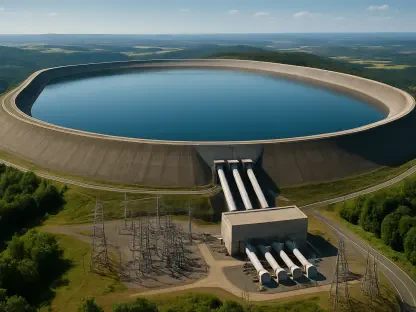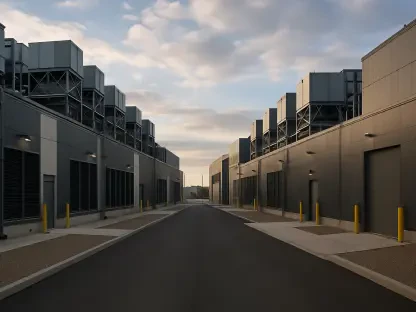In a landmark development that highlights the increasing intersection between traditional energy production and cutting-edge technology, Pennsylvania is transforming its former Homer City generating station into a natural gas-powered facility named the Homer City Energy Campus. This monumental project aims to meet the burgeoning energy demands of the Artificial Intelligence (AI) and high-performance computing sectors. With an initial capital investment surpassing $10 billion, this redevelopment represents a significant milestone in Pennsylvania’s power infrastructure and its readiness for the future.
Transformation to Address AI’s Power Demands
Redevelopment Strategy
The Homer City Energy Campus is poised to take a considerable leap in modernizing energy production. Spearheaded by Homer City Redevelopment, the natural gas-powered facility is designed to use existing infrastructure from the former coal plant. Incorporating vital components such as transmission lines and substations, the redevelopment ensures seamless integration with multiple power grids. Engineering, procurement, and construction will be managed by Kiewit Power Constructors, leveraging their expertise to efficiently transition the site into a cutting-edge power generation facility.
A key feature of the revamped plant is the inclusion of seven 7HA.02 hydrogen-enabled gas turbines supplied by GE Vernova. Initial deliveries of these state-of-the-art turbines are anticipated by 2026. Scott Strazik, CEO of GE Vernova, underscored the project’s potential to supply affordable and reliable energy, stimulate local economic growth by creating skilled jobs, and position Pennsylvania as a leader in AI advancement. This venture not only revitalizes existing infrastructure but also emphasizes the importance of modernization in meeting contemporary energy needs.
Economic and Environmental Impact
Spanning over a vast 3,200-acre site, the Homer City Energy Campus promises to significantly reduce greenhouse gas emissions by 60% to 65% per megawatt hour compared to the former coal plant. Environmental benefits are coupled with considerable economic impacts, as the project is slated to generate 10,000 construction jobs and 1,000 permanent positions across various sectors. The use of natural gas sourced from the Marcellus shale region further bolsters the US effort to curb the escalating energy crisis, ensuring a steady supply of clean energy.
William Wexler, president and CEO of Homer City Redevelopment, emphasized the project’s commitment to honoring Pennsylvania’s rich history of energy generation. This approach aims to strike a balance between preserving legacy and addressing the growing energy demands of the future. By integrating cutting-edge technology and sustainable practices, the project not only preserves historical significance but also propels the state and Mid-Atlantic region into a new era of energy production.
Strategic Investments Fueling Progress
Partnership Contributions
In addition to the central role of GE Vernova’s hydrogen-enabled turbines, the broader framework of strategic alliances continues to fuel the project’s advancement. In March 2025, GE Vernova signed a strategic framework agreement with Amazon Web Services (AWS) to address the rising global energy demand. This collaboration underscores the trend of prominent investments and innovation in energy infrastructure, as major industry players seek sustainable and scalable solutions for future energy challenges.
The financial backbone of the project remains strong with Knighthead Capital Management, a prominent equity holder in Homer City for nearly eight years, leading the charge in project financing. This established financial leadership ensures that the ambitious milestones of the Homer City Energy Campus will be met. The emphasis on robust financial planning and strategic partnerships reflects the project’s overarching goal of delivering a reliable energy source for the AI and high-performance computing sectors.
Future-Oriented Perspective
The transformation of the Homer City generating station into a natural gas-powered facility is not just a technological and infrastructural feat, but a visionary step towards addressing future energy demands. The inclusion of advanced gas turbines and strategic alliances with industry giants like AWS demonstrates a commitment to sustainability and innovation. This initiative sets a strong precedent for similar projects nationwide, highlighting the seamless marriage between energy production and advanced technological applications.
By repositioning the Homer City Energy Campus at the forefront of energy production, Pennsylvania is laying the groundwork for a robust and resilient energy landscape. The redevelopment underscores the state’s commitment to innovation, sustainability, and economic growth, fostering a collaborative environment where technology and traditional sectors converge. The expected outcomes include not only a significant reduction in greenhouse gas emissions but also the establishment of Pennsylvania as a leader in next-generation energy solutions.
A Vision for the Future
In a landmark development showcasing the growing synergy between traditional energy production and modern technology, Pennsylvania is repurposing its former Homer City generating station into a natural gas-powered facility, now named the Homer City Energy Campus. This ambitious project is designed to cater to the rising energy requirements of the Artificial Intelligence (AI) and high-performance computing industries. With an initial capital investment exceeding $10 billion, this redevelopment marks a pivotal milestone in Pennsylvania’s energy infrastructure. The transformation exemplifies the state’s proactive approach to meeting future energy demands, especially given the rapid advancements in technology sectors. As AI and computing power needs continue to grow, having a dedicated energy source is critical for maintaining operational efficiency and supporting technological progress. This project not only reinforces Pennsylvania’s commitment to modernizing its energy resources but also prepares the state to remain competitive in the fast-evolving technological landscape.









